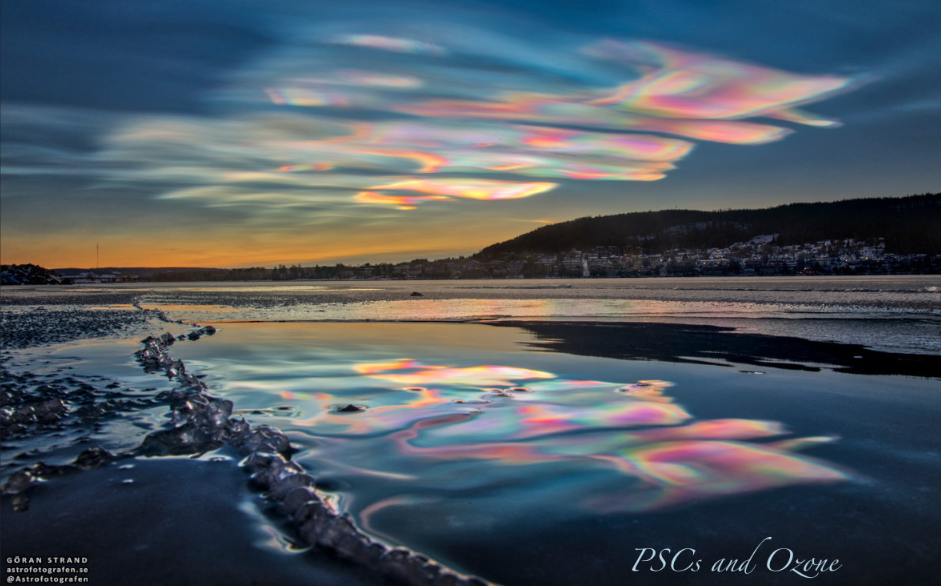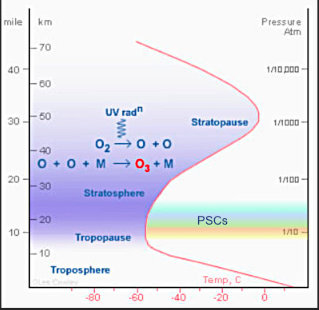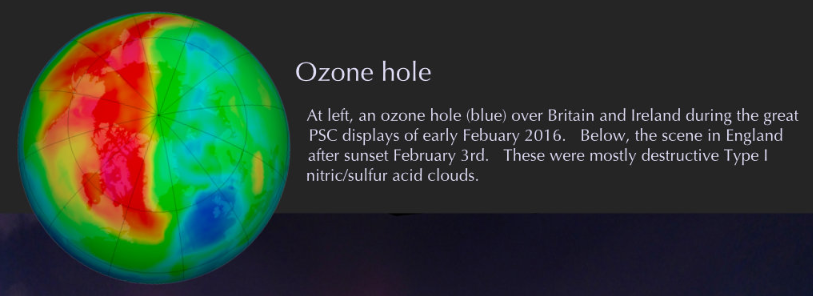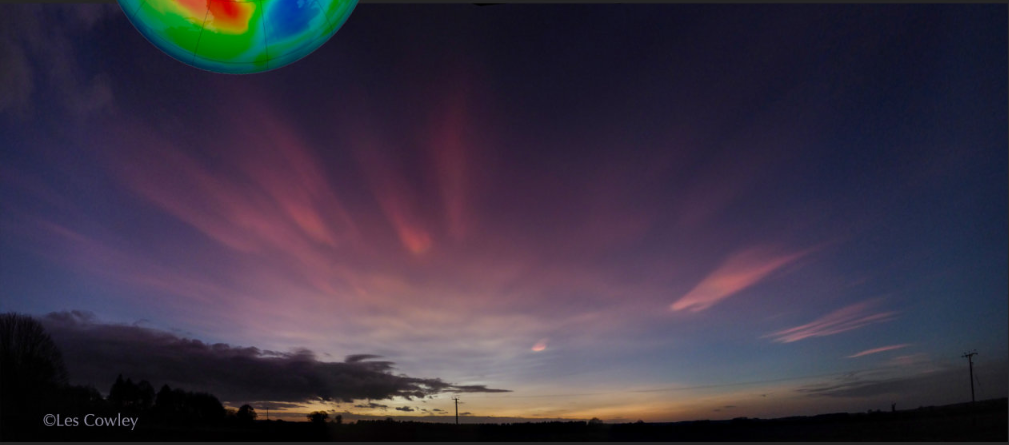PSCs and Ozone
PSCs and Ozone: Exploring the Relationship between Spectacular Clouds and Atmospheric Protection
Have you ever witnessed the mesmerizing beauty of Polar Stratospheric Clouds (PSCs)? These stunning natural phenomena, captured in a recent photograph taken by Göran Strand in Östersund, Sweden, display vibrant iridescent colors against the backdrop of a twilight sky. PSCs illuminate the atmosphere with their radiant hues, thanks to the remaining high-altitude sunlight even after the sun has set at ground level. However, beyond their enchanting appearance, PSCs reveal a darker side, intimately connected to the delicate balance of ozone in our atmosphere.
To comprehend the intricate relationship between PSCs and ozone, we must first delve into the thermal structure of our atmosphere. As we ascend into the stratosphere, the air temperature decreases, reaching its lowest point at the tropopause. On average, this minimum temperature hovers around -55 degrees Celsius. However, for PSCs to form, the temperature must plummet even further, dropping below an astonishing -85 degrees Celsius.
The stratosphere, situated above the tropopause, experiences warming due to the absorption of solar radiation by ozone. Ozone forms at higher altitudes through chemical reactions triggered by the absorption of far ultraviolet (UV) radiation by oxygen molecules. Not only does ozone play a crucial role in determining the thermal structure of our atmosphere, but it also acts as a vital shield against harmful and potentially lethal UV radiation for life on Earth.
Curiously, destructive Type I PSCs tend to occupy the very region where ozone concentrations are most concentrated. These clouds, often appearing less iridescent and frequently surrounding Type II clouds like those captured by Göran Strand's camera, are composed of mixtures of water, nitric acid, and sulfur acid. Their surfaces act as catalysts for a series of chemical chain reactions that contribute to the destruction of life-sustaining ozone.
Type II PSCs, on the other hand, are harmless. These PSCs consist of tiny ice crystals and only form under abnormally low temperatures near the tropopause, typically around -85 degrees Celsius. Göran Strand's captivating photograph showcases the beauty of Type II clouds with their bright iridescence. Although visually stunning, these clouds pose no threat to the ozone layer or life on Earth.
However, it is crucial to recognize that the destruction of ozone is not solely attributed to PSCs. Anthropogenic emissions of chlorofluorocarbons (CFCs) have significantly contributed to the depletion of ozone in the past. Fortunately, a rare international agreement was reached in Montreal in 1987, leading to the phase-out of CFCs. As we face the challenges posed by the climate emergency, similar global action is needed to protect and preserve our atmosphere.
The impact of PSCs on ozone is evident in the occurrence of ozone holes, which are regions of significantly reduced ozone concentrations. During the great PSC displays in early February 2016, an ozone hole appeared over Britain and Ireland, as depicted in the accompanying image. The photograph taken in England after sunset on February 3rd reveals the presence of predominantly destructive Type I nitric and sulfur acid clouds. Two days earlier, there were more Type II clouds, emitting their vibrant iridescence but still intermingled with murky Type I clouds.
In conclusion, Polar Stratospheric Clouds (PSCs) offer a captivating display of colors against the twilight sky. However, their existence also sheds light on the delicate balance of ozone in our atmosphere. While harmless Type II PSCs grace our skies with their beauty, destructive Type I PSCs contribute to the destruction of life-sustaining ozone. Understanding this relationship between PSCs and ozone emphasizes the importance of global efforts to protect and preserve our atmosphere, ensuring a sustainable future for all.

A recent spectacular display of Polar Stratospheric Clouds (PSCs) over Östersund, Sweden photographed by Göran Strand (Photography). They shine with unbelievably bright iridescent colours against a twilight sky. They are lit by remaining high altitude sunlight after the sun has already set at ground level.
But there is a darker side...
Air temperature decreases with height reaching a minimum at the tropopause. The graph shows the 'normal' minimum of about -55 Celsius. For
PSCs to form the minimum must be much lower, below -85 Celsius.
The stratosphere above the tropopause warms from solar radiation absorption by ozone. The ozone forms at higher altitudes from reactions following absorption of far UV radiation by oxygen molecules.
Ozone determines the thermal structure and mixing of our atmosphere. It protects life from harmful and possibly lethal UV radiation.
Destructive Type IPSCs sit just where ozone is most concentrated!

PSCs are 9-16 miles high in the stratosphere. That is inside the ozone layer which shields life
from the sun's harmful ultra-violet radiation.
PSCs come in more than one flavour.
Göran's bright iridescent clouds are 'Type II' and are tiny ice crystals. They only form at
abnormally low temperatures of -85 Celsius near the tropopause. They are beautiful and
they are harmless
Type I PSCs are not harmless. They are less or non-iridescent and often surround Type II
clouds as muddy accompaniments. Some may be in Göran's image.
They are mixtures of water, nitric and sulfur acids. Their surfaces act as catalysts to a series
of chemical chain reactions that destroy life permitting ozone.
The destruction is increased by anthropogenic chlorofluorocarbon emissions. Fortunately
there was a rare international accord (Montreal 1987) to phase them out. The climate
emergency calls for similar action.

Ozone hole
At left, an ozone hole (blue) over Britain and Ireland during the great PSC displays of early Febuary 2016. Below, the scene in England after sunset February 3rd. These were mostly destructive Type I nitric/sulfur acid clouds.

Two days earlier there were more Type II clouds iridescing brightly. But still embedded in murky Type I.

Note: this article has been automatically converted from the old site and may not appear as intended. You can find the original article here.
Reference Atmospheric Optics
If you use any of the definitions, information, or data presented on Atmospheric Optics, please copy the link or reference below to properly credit us as the reference source. Thank you!
-
<a href="https://atoptics.co.uk/blog/pscs-and-ozone/">PSCs and Ozone</a>
-
"PSCs and Ozone". Atmospheric Optics. Accessed on April 19, 2024. https://atoptics.co.uk/blog/pscs-and-ozone/.
-
"PSCs and Ozone". Atmospheric Optics, https://atoptics.co.uk/blog/pscs-and-ozone/. Accessed 19 April, 2024
-
PSCs and Ozone. Atmospheric Optics. Retrieved from https://atoptics.co.uk/blog/pscs-and-ozone/.